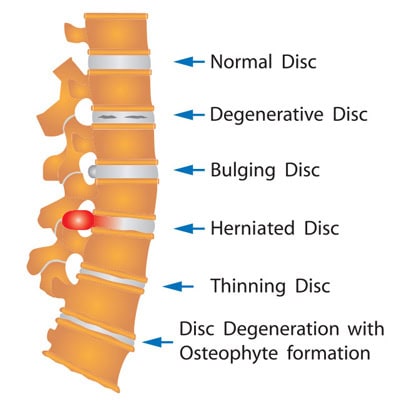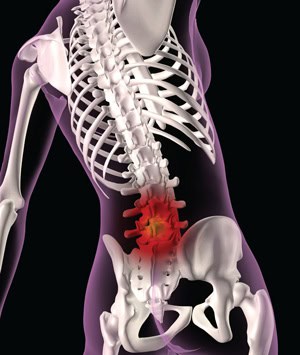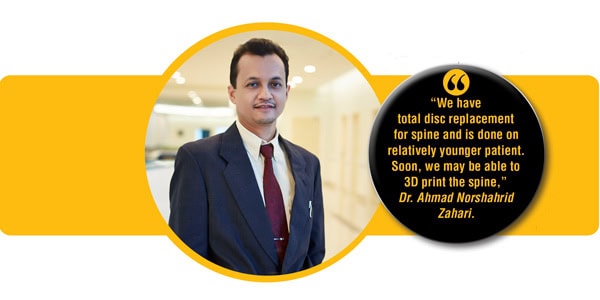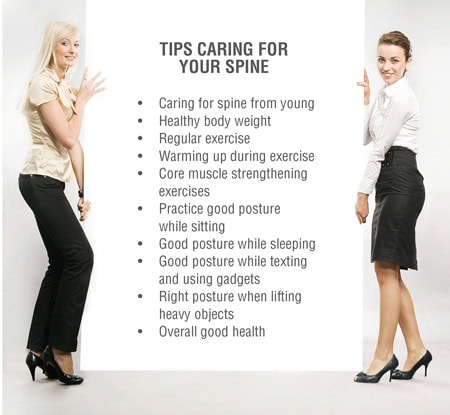Article credit : InfoMed Malaysia, Issue 20, Jan – Mar 2017
Back pain is a huge problem which affects a major segment of the population and the trending current lifestyle is poised to aggravate the situation more unless we take preventive measures.
A frequent medical condition for sick leave is the common back problem. It could be due to arthritis, bone spurs, or bulging or herniated discs in the spine. Pain resulting from these conditions stems from compressed nerves in the spine which potentially can be prevented, minimised or treated.
Identifying the symptoms and getting a diagnosis that pinpoints the underlying cause of the pain is the first step in obtaining effective pain relief.
Common Spine Conditions

When the space between vertebrae and the spinal cord decrease, narrowing the spinal canal which can lead to the nerves getting pinched. Stenosis development is linked to lifestyle, aging or genetic predispositions over time.
Degenerative disc disease
A common symptom of aging, almost everyone has some degeneration in their spine, but not everyone shall experience the symptoms.
Bulging or herniated discs
Happens when a disc’s ability to serve as a shock absorber for the spine deteriorates when it protrudes or leaks, pushing on nerves in either the cervical or lumbar spine. About 9 in 10 cases of bulging discs occur in the lower back.
Sciatica
Sciatic nerve is the longest nerve in your body. And when this nerve gets pinched for the various reasons, you may feel pain, numbness or tingling throughout your legs.
Bone spurs
Also, known as osteophytes often created from joint-on-joint friction and inflammation triggered by arthritis. When the bony ends of the vertebrae rub directly on each other, forming extra, irregular bony growths that can compress spinal nerves. With age, bone spurs can develop when the soft disc between the vertebrae becomes thin and collapse narrowing the space between the vertebrae and pushes on spinal nerves.
For an everyday understanding of the spine, we caught up with two consultant surgeons, Dr. Ahmad Norshahrid Zahari, Consultant Orthopedic & Spine Surgeon and Dr. Paul Ngalap Ayu, Consultant Orthopedic & Pediatric Orthopedic/ Spine Surgeon from Columbia Asia Hospital – Petaling Jaya.

InfoMed: Caring for your spine from young is a noble lifestyle attitude. Your comments?
Caring of the spine involves the entire body. Lifestyle attitudes involve our general health, posture, our activities and discipline from the young. Especially now the youngsters are used to play games with gadgets and may not get their posture right and would cause problems later in life. The advice is that the habits should start from young.
InfoMed: Your advice to our young generation on better texting posture?
Spending too much time on gadgets can cause muscular strains. Musculoligamentous strain of neck and back is one of the commonest cause of lower back pain in the young generation. Currently, our younger generation spends more time with gadgets and texting messages. A good and correct posture of neck and back are important to prevent musculoligamentous strain. Good posture would be keeping the neck and back straight and the screen of the gadget at eye level always. Less texting and playing with the gadget is advisable.

InfoMed: How can one assure he/she is keeping up with a healthy spine?
Patient education is very important. They must know the importance of maintaining correct posture and core muscle strengthening to prevent back pain. Healthy lifestyle such as regular exercises, not smoking, maintaining good posture while working and doing daily activities, maintaining an ideal body weight and a good diet are some of the factors to maintain a healthy spine.
InfoMed: Stretch your way to a healthy spine. Your comments?
Stretch is only a small component of the exercise itself. Warming up and core muscle strengthening is equally important when you do exercise.
InfoMed: Inflammation is a common culprit of neck and back pain. How do avoid it?
Inflammation of the spine can be due to degenerative changes, overuse, trauma and sometimes infection. The pathological process can occur at the back muscles, intervertebral discs, facet joints and the ligaments. Stretching and warming up before any sports activities can reduce musculoligamentous inflammation. Maintaining good posture while working and doing daily activities from young will prevent the early degenerative process of the spine.
InfoMed: Is overweight making one’s spine work harder?
Overweight will cause more axial pressure to the spinal column including the intervertebral discs, facet joints, ligaments and muscles. This unnecessary stress will make the spine more susceptible to injury, sprain and strain, and early degenerative process and can lead to protrude or even prolapse discs.

InfoMed: Sleep right, how important is it?
As spine surgeons, we recommend to our patients to sleep right. Good positions for sleeping would be to lie on the right side or in a supine position where you are facing up. Sleeping in a prone position which is lying face down is bad for the spine as it causes stress to your back muscles and joints. A good firm mattress is also important for caring your back. A common issue is sleeping on the sofa which causes, spasm, stiffness and backache. This must be avoided.
InfoMed: On new treatments for chronic back pain?
In general, the treatment of the spine can be classified into conservative and operative. Conservative treatment would be medication, core muscle exercise, acupuncture and physiotherapy especially with the new modalities and operative include percutaneous decompression, minimally invasive and open surgeries.
There are many new medications developed such as NSAIDs, COX-inhibitor and GABA analogues for treatment of chronic back pain. Currently, these drugs are used in combination for a synergistic effect in controlling the pain and to reduce their side effects. Physiotherapy too has improved in recent years with new techniques and equipment to reduce chronic back pain.
Currently, there are percutaneous procedures such as Percutaneous Disc Coagulopathy Therapy (PDCT), Nucleoplasty and Radiofrequency Ablation therapy to reduce the chronic back pain of disc and facet joint origin. These procedures can be done as a daycare surgery with no surgical incision required. They are safe procedures with success rates up to 90%. However, the cases need to be screened by a spine surgeon to determine if the patient is suitable for these procedures. We perform PDCT here in Columbia Asia Hospital, Petaling Jaya.
For open surgery, Minimally Invasive Spine Surgery (MISS) is an option to minimize wound scar and complications. In MISS, a keyhole incision is made to do spinal procedures such as removing the intervertebral discs, inserting pedicles screws and even correcting spinal deformities and spinal stabilization.

InfoMed: Are supplements recommended for a healthy spine?
For prevention, it would be advisable, especially for elderly patients. There is no specific supplement for the spine, indirectly yes.
InfoMed: What are the common conditions in aging spines?
In aging spine, the water and protein content of the intervertebral disc reduces. And, in turn, reduces the strength and turgidity of the affected discs. The weakened degenerated discs will get compressed from the axial force caused by the person weight and may cause axial back pain. The degenerated disc may bulge posteriorly and may compress the nerve root causing radiculopathy or sciatica. It may also cause the narrowing of spinal canal resulting in spinal stenosis.
Apart from discs, the facet joints will also degenerate causing back pain on movement and may form bone spurs which will further narrow the spinal canal. Weakened facet ligaments and altered mechanics of degenerated facet joints tend to cause degenerative spondylolisthesis in which one vertebra slips against another vertebra. The spinal column will become more unstable and get prone to back pain, neurological impairment and injury.
InfoMed: Your advice and tips on caring for an aging spine?
The caring for the spine begins from young which would be the easier approach. You should maintain a healthy weight which would support your other actions which are equally important. That includes regular exercise and physical activity that ease your muscle tension and inflammation and strengthen your back muscles and connective tissues. Another very important tip, especially much relevant today is practicing good posture while sitting, sleeping and lifting and carrying heavy objects.
InfoMed: When is spine surgery recommended?
When all conservative management fails, usually after 3 to 6 weeks’ duration with positive clinical and radiographic findings.
Surgery when the patient starts to lose the ability to control his bladder and bowel function, a condition known as cauda equina syndrome or when the spinal problem causes severe debilitation to the patient. Apart from that, fracture is also one of the indications for surgery.
There is no age limit if the patient is fit for the surgery.
InfoMed: Back pain is the primary cause of disability in people under 50 years of age. Your comment?
It is the most common reason for absenteeism from the job. Studies have shown that almost 80% of those above 40 years old experience one episode of back pain in a year. Poor posture, non-healthy lifestyle and trauma are some of the causes of back pain in younger person.
InfoMed: On minimally invasive spine surgery (MISS) and its advantages?
MISS involves keyhole incision, therefore smaller surgical scar, faster wound healing, fewer days hospital stay, less bleeding, less risk to wound infection and less damage to surrounding structures.
However, only trained and skilled spine surgeon can perform MISS procedures.
In Columbia Asia Hospital Petaling Jaya, we do all procedures as in every spine centers including on children. We have our physio center for follow-up and recuperation.
Points To Consider When Diagnosing ‘Red Eyes’ in Primary Care Setting – InfoMed Malaysia, Issue 20, Jan – Mar 2017.
Share:
Was this article helpful?
Share:
Was this article helpful?
Health Packages
Elevate your health with tailored health packages at Columbia Asia Hospital. Take charge of your health journey today.
Pink October 2024
From
RM80
HLA Policyholders Promo: Influenza Vaccination
RM65
Find Out MoreColumbia Asia 30th Anniversary Promotion “Maternity & Baby”
12.12 CheckJer Health Package
RM140
Find Out MoreAIA Policyholders Self-pay Benefits
Pink October 2025
From
RM80

